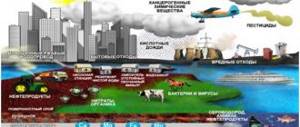Presentation “Global Environmental Problems”
GLOBAL
ECOLOGICAL
PROBLEMS
Author: Myandin Zakhar, 9th grade, MBOU “Pizhemskaya Secondary School”, Zamezhnaya village, Ust-Tsilemsky district, Komi Republic
Teacher – Potashova Marina Aleksandrovna
What kind of world do we live in?
We live in the world of the information society, the world of highest achievements and high technologies. Over the past decades, the lives of billions of people on Earth have changed dramatically. This is primarily due to the intensive development of scientific and technical knowledge, the development of industry and cities, and the emergence of more and more new technologies.
A brewing crisis.
The rapid progress of science and technology, on the one hand, made it possible to satisfy all the needs of human society, but on the other hand
, it worsened the conditions of its existence.
Global environmental problems.
Today, environmental problems are simply surprising in their scale, and therefore the environmental situation in the world can be defined as critical.
Among the Global Environmental Problems, several of the most important ones can be identified.
Global environmental problems.
Destruction of the ozone layer.
The main amount of ozone is formed in the upper layer of the atmosphere - the stratosphere, at altitudes from 10 to 45 km. The ozone layer protects all life on Earth from the harsh ultraviolet radiation of the Sun. By absorbing this radiation, ozone significantly affects the temperature distribution in the upper atmosphere, which in turn affects the climate.
Global environmental problems.
Destruction of the ozone layer.
Depletion of the planet's ozone layer leads to the destruction of the existing biogenesis of the ocean due to the death of plankton in the equatorial zone, inhibition of plant growth, a sharp increase in eye and cancer diseases, as well as diseases associated with the weakening of the immune system of humans and animals, increased oxidative capacity of the atmosphere, corrosion of metals, etc. .d.
Global environmental problems.
Pollution of the water eco-system.
The problem of water pollution (sea, rivers, lakes, etc.) is one of the most pressing. Human activity irrevocably changes the natural regime of water bodies through waste and discharges. There is a lot of water on Earth, only 3% is fresh water, the remaining 97% is water from the seas and oceans. Three-quarters of fresh water is not available to living organisms, as it is glacial water. Glacial water is a reserve of fresh water.
Global environmental problems.
Pollution of the water eco-system.
Almost the entire mass of water is concentrated in the oceans. Water evaporating from the surface of the oceans provides moisture to all land ecosystems. The land returns water to the ocean.
Before the development of human civilization, the water cycle on the planet was in equilibrium. The ocean received from the rivers the amount of water that it consumed during its evaporation. With a constant climate, the rivers did not become shallow, and the water level in the lakes did not decrease. With the development of human civilization, this cycle was broken. Ocean pollution has reduced the amount of water that evaporates from the oceans. Rivers in the southern regions have become shallow. All this led to a deterioration in the water supply to the biosphere. Droughts and various environmental disasters are becoming frequent occurrences.
Global environmental problems.
Pollution of the water eco-system.
A previously inexhaustible resource – fresh water – is now becoming exhaustible. In many areas of the world there is not enough water for drinking, irrigation, and industrial production. This problem is very serious as water pollution will affect future generations. Consequently, this problem requires an urgent solution; the problem of industrial discharges must be radically reconsidered.
Global environmental problems.
Earth's climate change.
Second half of the 20th century was marked by the rapid development of industry and an increase in energy availability, which could not but affect the climate on the entire planet. Modern scientific research has established that the influence of anthropogenic activities on the global climate is associated with several factors, especially with an increase in:
- the amount of atmospheric carbon dioxide, as well as some other gases entering the atmosphere during economic activities and enhancing the greenhouse effect in it;
- masses of atmospheric aerosols;
- thermal energy generated in the process of economic activity and released into the atmosphere.
Global environmental problems.
Earth's climate change.
Second half of the 20th century was marked by the rapid development of industry and, accordingly, an increase in energy availability, which could not but affect the climate on the entire planet. Over time, scientific research has established that the influence of anthropogenic activities on the global climate is associated with several factors, especially with an increase in:
- the amount of atmospheric carbon dioxide, as well as some other gases entering the atmosphere during economic activities and enhancing the greenhouse effect in it;
- masses of atmospheric aerosols;
- thermal energy generated in the process of economic activity and released into the atmosphere.
Global environmental problems.
Earth's climate change.
The main contribution (65%) to warming is made by carbon dioxide, which is formed as a result of the combustion of coal, oil products and other types of fuel. Terminating this process in the coming decades seems technically infeasible. In addition, energy consumption is growing rapidly in the developing world.
An increase in the amount of CO2 in the atmosphere has a noticeable effect on the Earth's climate, changing it towards warming. The general trend towards an increase in air temperature, which was observed in the 20th century, is intensifying, which has already led to an increase in average air temperature by 0.6 °C.
Global environmental problems.
Earth's climate change.
The following consequences of global warming are predicted:
- an increase in the level of the World Ocean due to the melting of glaciers and polar ice (over the past 100 years it has already risen by 10-25 cm), which in turn will lead to flooding of territories, displacement of the boundaries of swamps, increased salinity of water at river mouths, as well as potential loss places of residence of a person;
- changes in precipitation (it will increase in the northern part of Europe and decrease in the southern part);
- changes in the hydrological regime, quantity and quality of water resources.
Studying the planet's environmental problems
Conservation science is not limited to biology, which deals with animal and plant life. At the intersection of two sciences, the interaction of man with nature is studied. Eco discipline is related:
- with social studies;
- geology;
- cosmology.
The term ecology is acquiring a broader interpretation. Human impact on the environment as a conservationist is fundamental. Global ecology studies the environmental problems of the Earth as a planet. The main object of the study is to consider the biosphere in the form of the main terrestrial ecosystem. Science is divided into 2 branches of interaction:
- Theoretical, examines organization within ecosystems.
- Applied - studies disturbances in the life of the biosphere and develops ways to preserve the environment.
The list of main tasks of global ecology includes:
- Study of nature's adaptation to anthropogenic impact.
- Organization of ecosystem modeling in dynamics.
- Conservation and rational use of resources.
Global ecology helps to find a balance between the development of technology and the condition of the Earth. Observing and identifying the principles of adaptation of animals and plants to anthropogenic impact reduces the risk of destruction of the planet's environmental resources.










